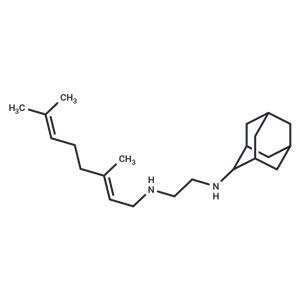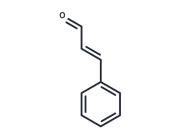| Name | SQ109 |
| Description | SQ109 (NSC-722041) is an effective inhibitor of the trypomastigote form of the parasite (IC50 = 50 nM). SQ109 is an antitubercular agent and targets MmpL3. |
| In vitro | SQ109 causes major ultrastructural changes in all three life cycle forms. SQ109 inhibits extracellular epimastigotes (IC50 = 4.6μM) and the clinically relevant intracellular amastigotes (IC50 = 0.5 - 1 μM), with a selectivity index of 10 to 20. SQ109 has little effect (EC50 = 80 μM) in a red blood cell hemolysis assay[1]. |
| In vivo | The t1/2 of SQ109 in dogs (12-29 h, mean 29.3 h) is longer than in rats (7-8 h, mean 7.4 h), as reflected by the significantly larger volume of distribution of SQ109 in dogs. The oral bioavailability of SQ109 in rats and dogs is 12% and 5%, respectively[2]. SQ109 (0.1-25 mg/kg) to the mice for 28 days results in dose-dependent reductions of mycobacterial load in both spleen and lung comparable to that of EMB(100 mg/kg), but is less potent than isoniazid(25 mg/kg). Pharmacokinetic profiles of SQ109 in mice following a single administration showed its Cmax as 1038 (i.v.) and 135 ng/mL (p.o.), with an oral Tmax of 0.31 h and an oral bioavailability of 4%. The elimination t1/2 of SQ109 is 3.5 (i.v.) and 5.2 h (p.o.)[3]. |
| Storage | Powder: -20°C for 3 years | In solvent: -80°C for 1 year | Shipping with blue ice. |
| Solubility Information | DMSO : 80 mg/mL (242.02 mM), Sonication is recommended.
|
| Keywords | Parasite | SQ 109 | NSC-722041 | NSC722041 | Bacterial | Inhibitor | SQ109 | inhibit | Antibiotic | SQ-109 |
| Inhibitors Related | Picaridin | PHYTOL | Kaempferol | Hydroxychloroquine | Metronidazole | Nitazoxanide | Doxycycline | Chloroquine phosphate | Diethyltoluamide | Artemisinin | Benzyl benzoate | DL-Methionine |
| Related Compound Libraries | Anti-Parasitic Compound Library | Bioactive Compound Library | ReFRAME Related Library | Drug Repurposing Compound Library | Inhibitor Library | Orally Active Compound Library | Clinical Compound Library | Bioactive Compounds Library Max |

 United States
United States



